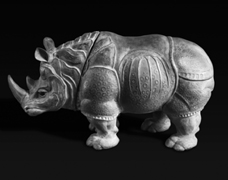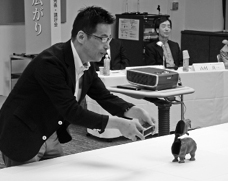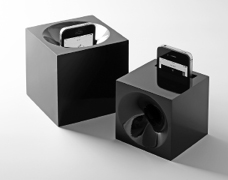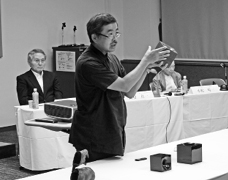Discussion
審査講評(3)
Comment on the Grand Prize and the 10th Exhibition Special Memorial Prize winners

犀の賽銭箱
Incense Container Rhino
H13.5×W10×D24
2013

彦十蒔絵 若宮 隆志
HIKOJUMAKIE
WAKAMIYA, Takashi
(JAPAN)

蓄音木ピアノブラック
Sound Booster
Grand :H12×W12×D12
Upright :H9.7×W9.7×D9.7
2014

東 康弘
AZUMA, Yasuhiro
(JAPAN)
Ohnishi ───── The Grand Prize goes to “Incense Container Rhino” by Takashi WAKAMIYA. The title is interesting in Japanese, a kind of word play (Sai no Saisenbako). The form of the rhinoceros is excellent. This is a skillfully admirable piece that seems to improve the longer you study it. The unique point is to interact with the work and find its mechanism; you simply pull its neck and open it, then you find a small offertory chest that comes out from the inside of the work.
This artist has proposed a new style that we have never seen before. The work is created with excellent traditional techniques and the design possesses goodness, appeal and precision of Urushi. It embodies the future of Urushi ware.
Many works with animal motifs have been made, but this is quite a unique design due to its mechanism. It has broadened the field of arts and crafts because the artist introduces a new factor to enjoy the work; not only decorating and admiring but also touching and having fun.
Since ancient times, people have felt the power of the God from the rhinoceros.
The rhinoceros design has been used for relics in China. The rhinoceros horn was used as medicine in Japan. It has been preserved as medication for the Emperor Shomu in the Shosoin Treasury. This work makes us imagine various things by providing us with mysterious power of the rhinoceros and proposing various factors for our present-day lifestyle.
Next Ekuan will talk.
Ekuan ───── Before I explain the Grand Prize winner, I’d like to look at the changes of Japanese people’s assumptions about life. After the end of the Second World War, Japanese people were impressed and fascinated with American lifestyle including western goods and large household appliances. The Japanese asked for bright future without growing desperate although they were cast down. Their feeling “We are not going to be outdone” supported our economic growth and we obtained our present-day life in Japan. Some decades passed and now Japan is glutted with commodities. It appears as if the Japanese have nothing special to buy any more. Not many Japanese people are willing to study abroad or go sightseeing in other countries. Quite a few Japanese people have felt bored.
While I was trying to find an answer for such a situation by looking for novel and unique items, I discovered the field of Urushi.
In the past, Urushi sap was used as an antiseptic and coffins were coated with Urushi. Then Urushi was introduced to the field of arts and crafts. Especially during the Muromachi period ( 1336 - 1573 ) Urushi ware developed and surprisingly precise works were created, including Buddhist altar fittings.
However, after the Russo-Japanese War, Urushi art fell into oblivion as the military structure was strengthened.
A few years after the Second World War, a movement emerged to rediscover the time honored traditions of Japan in various disciplines including literature and architecture.
However, Urushi art seemed to have reached a limit with its post-war audience, I felt.
Looking at the applied works for this International Exhibitions these last several years, I could not find brilliant Makie works, amazingly precise works nor works full of novel ideas.
I was afraid that even Urushi art reached a limit.
However, this year, I found an excellent and novel Urushi artwork.
That is "Incense Container Rhino", the Grand Prize winner. The artist might have kept his eye on the shape of an animal and created the work by making the most use of Urushi art techniques after searching a way out of square boxes, triangle or any other superb ideas.
And the result is not only the completed work but also the technical mechanism he created from inside.
He thought how to show the work using the true, and very much alive, spirit of Urushi art. It is a lot of fun.
Ekuan ───── You will be surprised to see the design of this work. You will be more surprised to see its neck rotating and to see the offertory chest appearing gently out from the inside.
Its mechanism is well-done. It is a victory of technique. A design like this exhibiting Urushi in Japan has long history and tradition. It also has a future possibility. The present-day mechanism of design has been influenced by traditional mechanisms developed in Japan. It echoes the design of modern day electronics because most of the present-day mechanisms have developed out of the traditional Japanese design technique. We can imagine that if a family were to show this work to their guests who had possibly also brought their children, the guests would get so excited to experience this design and functionality would be a scene of frenzied excitement. Anyone who looks at the work, they will be amazed and in awe of a simple, yet highly complex design, which will no doubt, evoke a sense of richness to their lives.
Usually arts and crafts works are decorated in an alcove. When I came across this work, however, I felt as if a decently clothed Urushi ware were to undress their thick coatings of urushi and start to dance naked. It can also be described as a queen and witty work, which is truly avant-garde. I guess the artist hit on an idea that even Urushi could delight someone just like toy. It is the main missive of arts and crafts to delight someone. This time we accepted only this animal shaped work, but in a few years we might accept more works with a design and functionality like this. Anyway, this piece has created a big change in the drama and experience of human life.
If you stick to conventional arts and crafts design, you can never create such a work. At the Final Assessment, there was a discussion on this work; if this work is selected as an award winner, the quality of the Assessment Panel might be called into question. Finally we decided to give up our old-fashioned ways. I have experienced this on a personal level. I have been designing motorcycles for almost 70 years. I am thinking about the design of an airborne motorcycle in the near future.
In other words, destructive works can give way to creative works. It is important to make interesting and novel designs with deep consideration of the past, present, and future.
Ohnishi ───── We are going to introduce the 10th Exhibition Special Memorial Prize winner by Mr Yasuhiro AZUMA. Please listen to the sound out of his work.
Yamamura ───── You have listened to the sound that has come out of his design. The work is a set of two Urushi coated simple cubic boxes. This piece is designed to be used as speakers for the popular iPhone considering acoustic effects, one of the characteristics of Urushi.
He focuses on utilizing the range of the middle register in the ear in his Urushi design. He makes the most out of the characteristics of Urushi. The precise Urushi coating on the surface of the boxes helps amplify the sound pressure level. He brings out the best in such Urushi design by creating simple shapes of the boxes. Set your iPhone into the box, and you can enjoy quality sound from the Urushi coated boxed-shaped booster. The box does not need any external power source. Additionally you can use the box as a mobile phone holder or as a memo pad holder. It is a product with a clever purpose. These Wajima Urushi ware speakers were developed in the Ishikawa Prefecture and then they were introduced to the world. This work has been well-accepted by the Assessment Panel members especially because the designer focuses on the middle register of the ear and has devised a way to amplify a clear sound using Urushi ware.

